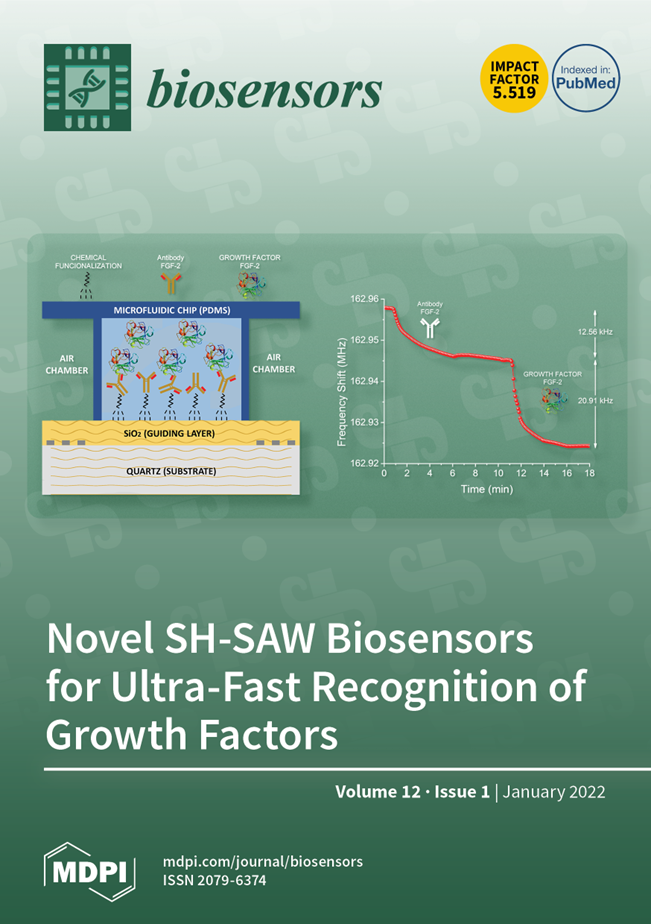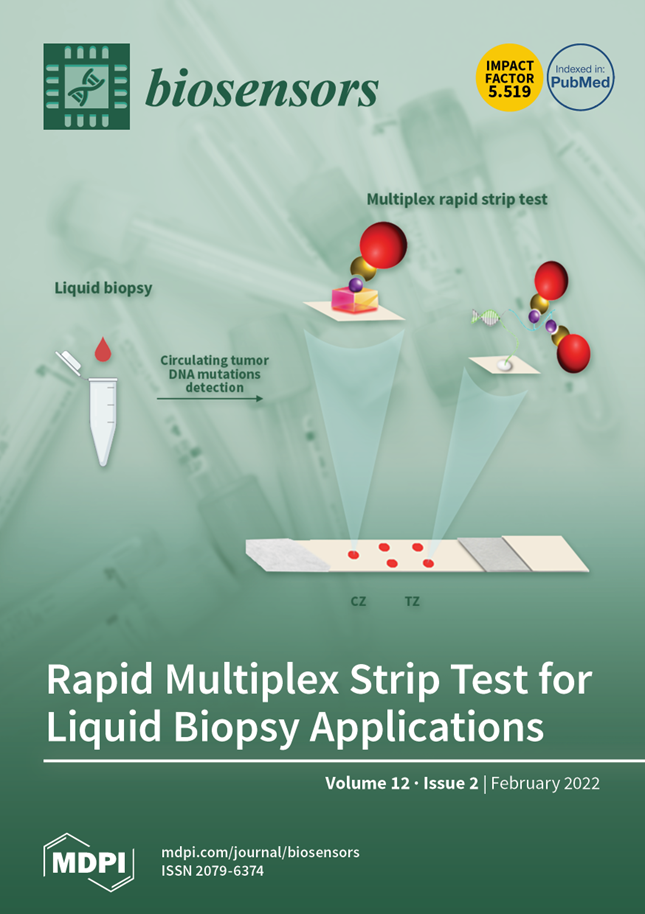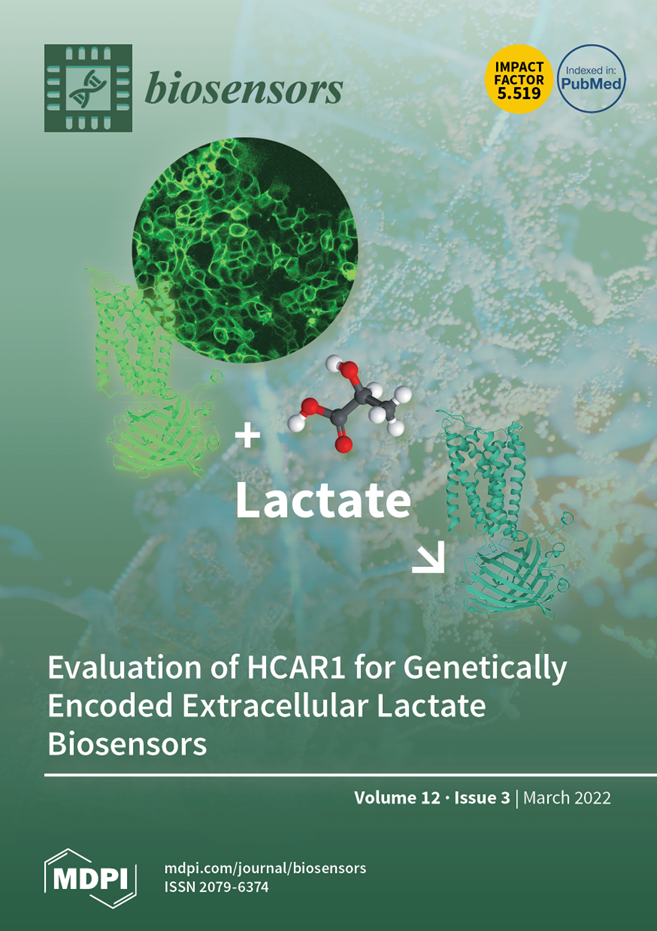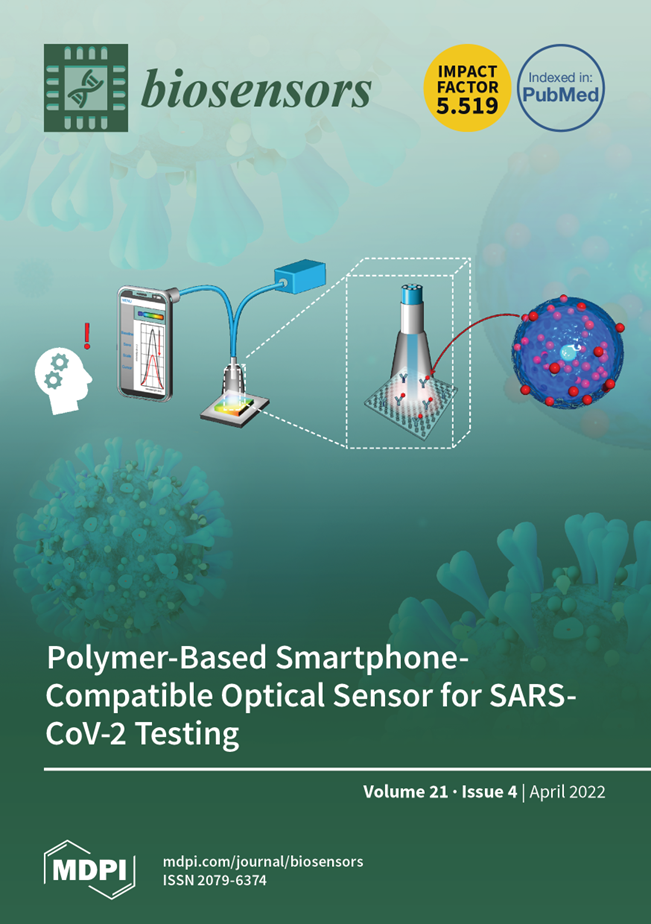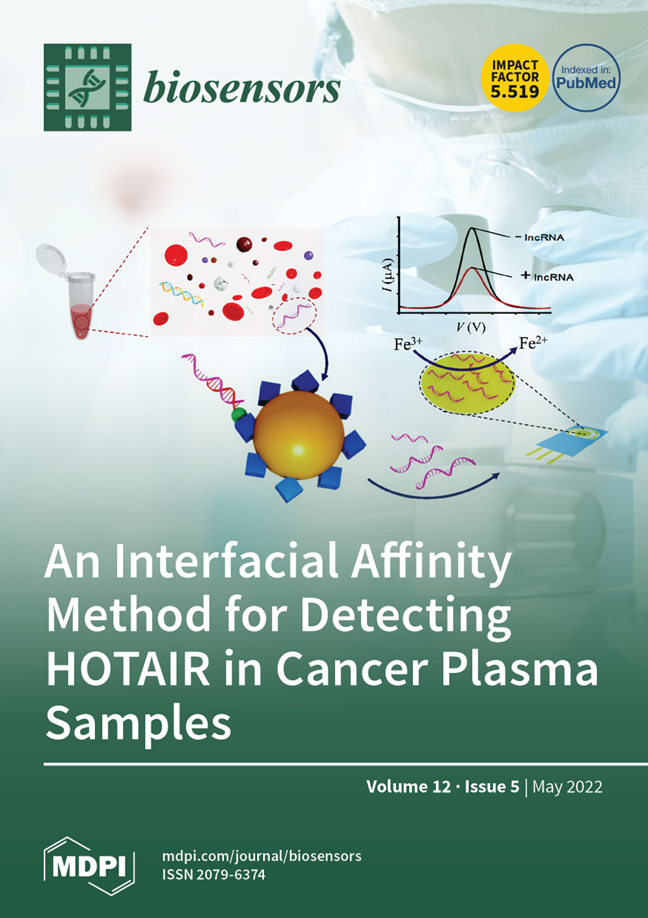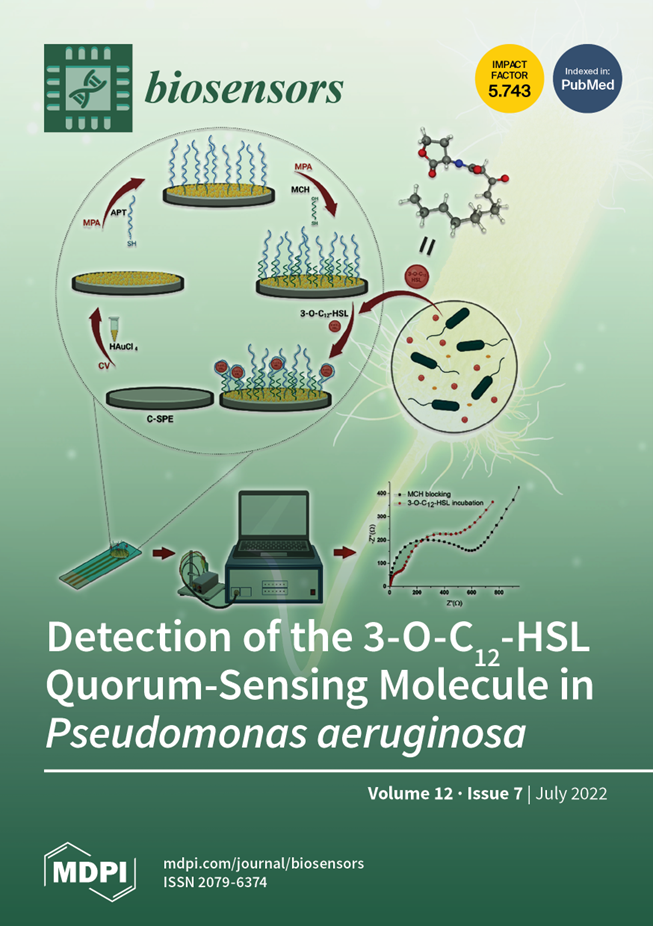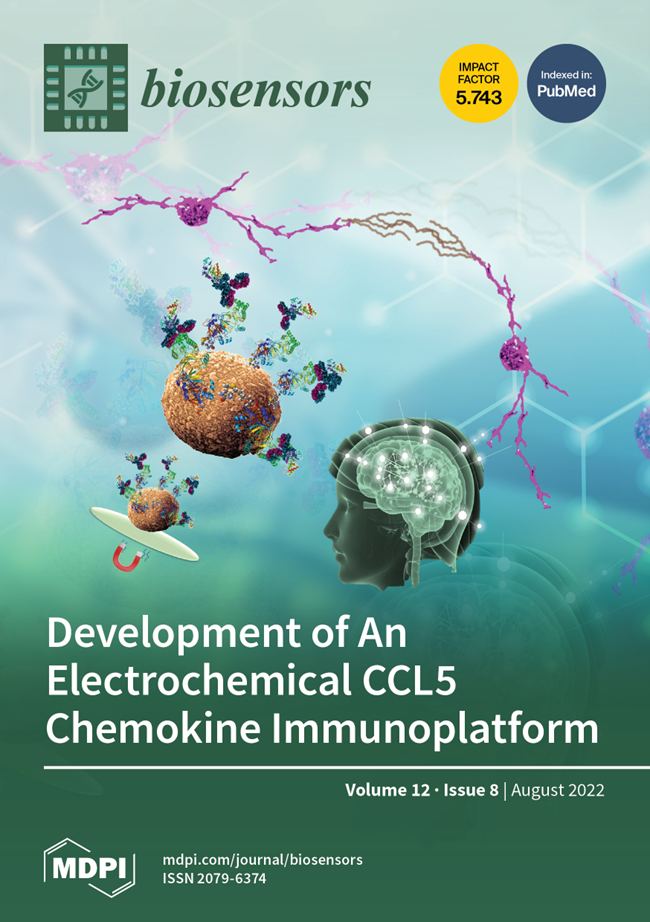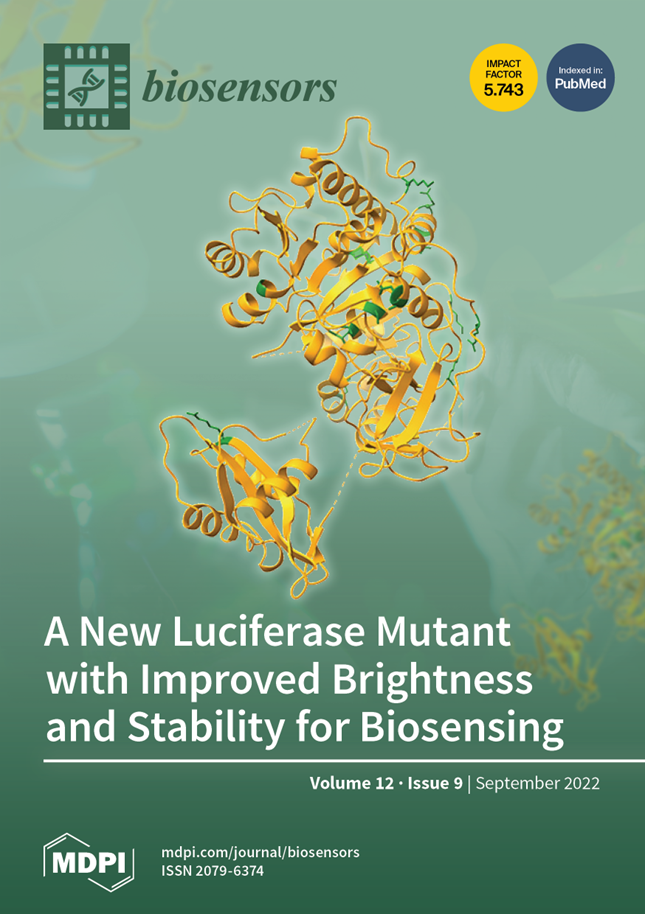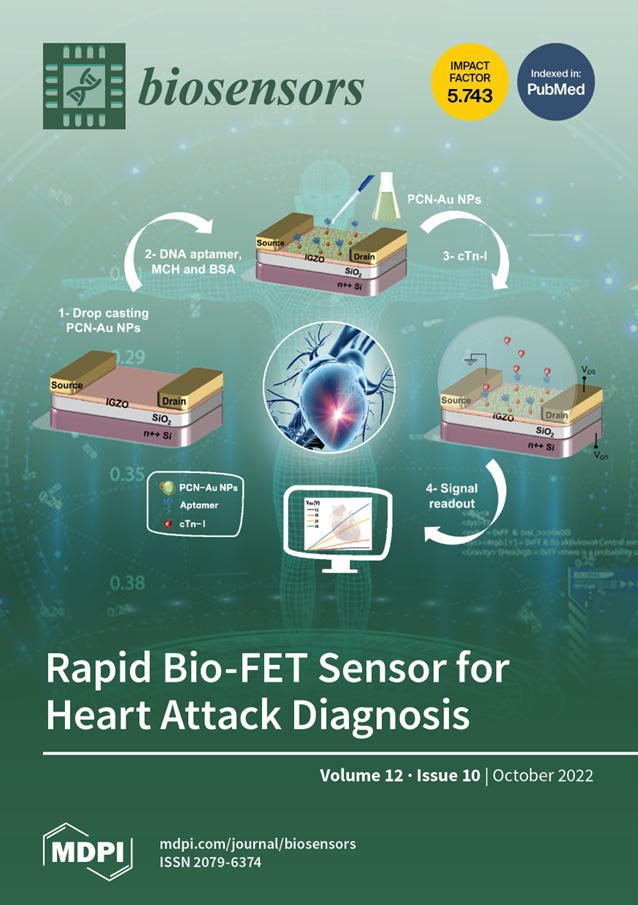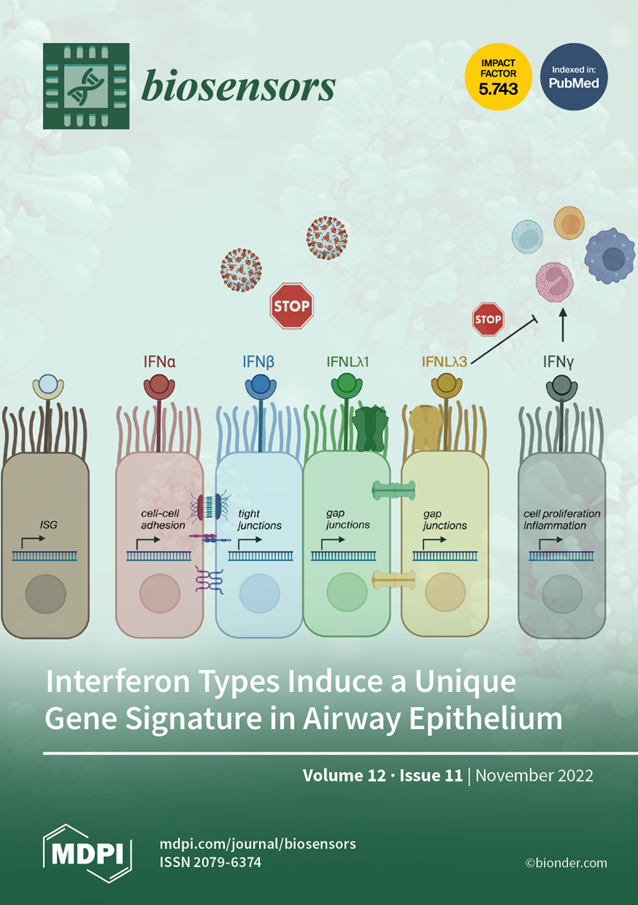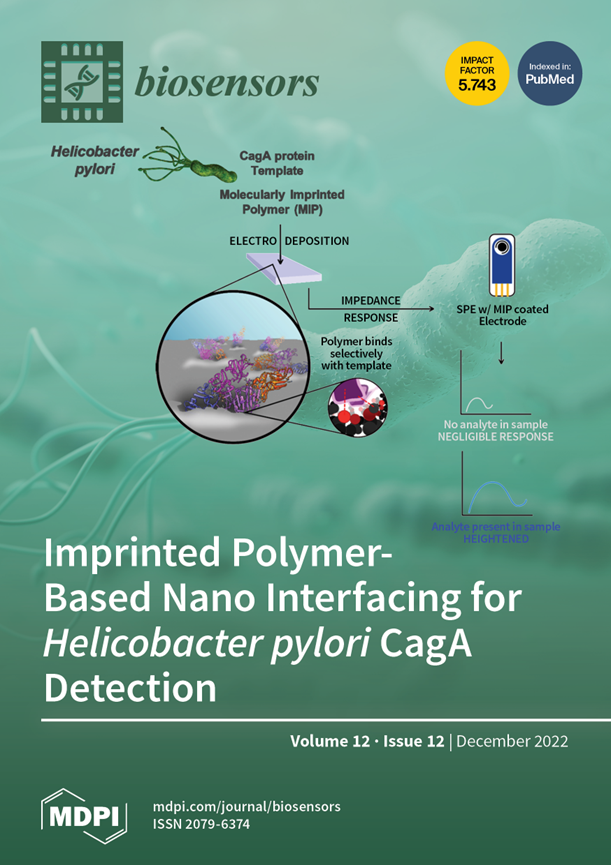
Journal Menu
► ▼ Journal Menu-
- Biosensors Home
- Aims & Scope
- Editorial Board
- Reviewer Board
- Topical Advisory Panel
- Instructions for Authors
- Special Issues
- Topics
- Sections & Collections
- Article Processing Charge
- Indexing & Archiving
- Editor’s Choice Articles
- Most Cited & Viewed
- Journal Statistics
- Journal History
- Journal Awards
- Conferences
- Editorial Office
Journal Browser
► ▼ Journal BrowserNeed Help?
Announcements
23 April 2023
Biosensors | Top 10 Cited Papers in 2021 in the Section “Optical and Photonic Biosensors”
1. “Highly Sensitive Twin Resonance Coupling Refractive Index Sensor Based on Gold- and MgF2-Coated Nano Metal Films”
by Kawsar Ahmed, Mohammed A. AlZain, Hasan Abdullah, Yanhua Luo, Dhasarathan Vigneswaran, Osama S. Faragallah, Mahmoud M. A. Eid and Ahmed Nabih Zaki Rashed
Biosensors 2021, 11(4), 104; https://doi.org/10.3390/bios11040104
Full text available online: https://www.mdpi.com/2079-6374/11/4/104
2. “Immunosensing Based on Optical Fiber Technology: Recent Advances”
by Maria Simone Soares, Miguel Vidal, Nuno F. Santos, Florinda M. Costa, Carlos Marques, Sónia O. Pereira and Cátia Leitão
Biosensors 2021, 11(9), 305; https://doi.org/10.3390/bios11090305
Full text available online: https://www.mdpi.com/2079-6374/11/9/305
3. “Surface Plasmon Resonance (SPR)- and Localized SPR (LSPR)-Based Virus Sensing Systems: Optical Vibration of Nano- and Micro-Metallic Materials for the Development of Next-Generation Virus Detection Technology”
by Kenshin Takemura
Biosensors 2021, 11(8), 250; https://doi.org/10.3390/bios11080250
Full text available online: https://www.mdpi.com/2079-6374/11/8/250
4. “Comprehensive Review Tapered Optical Fiber Configurations for Sensing Application: Trend and Challenges”
by Bakr Ahmed Taha, Norazida Ali, Nurfarhana Mohamad Sapiee, Mahmoud Muhanad Fadhel, Ros Maria Mat Yeh, Nur Nadia Bachok, Yousif Al Mashhadany and Norhana Arsad
Biosensors 2021, 11(8), 253; https://doi.org/10.3390/bios11080253
Full text available online: https://www.mdpi.com/2079-6374/11/8/253
5. “Recent Advancements in Aptamer-Based Surface Plasmon Resonance Biosensing Strategies”
by Chia-Chen Chang
Biosensors 2021, 11(7), 233; https://doi.org/10.3390/bios11070233
Full text available online: https://www.mdpi.com/2079-6374/11/7/233
6. “Biocompatible and Biodegradable Polymer Optical Fiber for Biomedical Application: A Review”
by Yue Wang, Yu Huang, Hongyi Bai, Guoqing Wang, Xuehao Hu, Santosh Kumar and Rui Min
Biosensors 2021, 11(12), 472; https://doi.org/10.3390/bios11120472
Full text available online: https://www.mdpi.com/2079-6374/11/12/472
7. “Using CNN and HHT to Predict Blood Pressure Level Based on Photoplethysmography and Its Derivatives”
by Xiaoxiao Sun, Liang Zhou, Shendong Chang and Zhaohui Liu
Biosensors 2021, 11(4), 120; https://doi.org/10.3390/bios11040120
Full text available online: https://www.mdpi.com/2079-6374/11/4/120
8. “Novel Micro-Nano Optoelectronic Biosensor for Label-Free Real-Time Biofilm Monitoring”
by Giuseppe Brunetti, Donato Conteduca, Mario Nicola Armenise and Caterina Ciminelli
Biosensors 2021, 11(10), 361; https://doi.org/10.3390/bios11100361
Full text available online: https://www.mdpi.com/2079-6374/11/10/361
9. “Trends in the Design of Intensity-Based Optical Fiber Biosensors (2010–2020)”
by Nerea De Acha, Abián B. Socorro-Leránoz, César Elosúa and Ignacio R. Matías
Biosensors 2021, 11(6), 197; https://doi.org/10.3390/bios11060197
Full text available online: https://www.mdpi.com/2079-6374/11/6/197
10. “High-Sensitivity High-Throughput Detection of Nucleic Acid Targets on Metasurface Fluorescence Biosensors”
by Masanobu Iwanaga
Biosensors 2021, 11(2), 33; https://doi.org/10.3390/bios11020033
Full text available online: https://www.mdpi.com/2079-6374/11/2/33
20 April 2023
Biosensors | Issue Cover Articles in 2022
The articles below have been selected as 2022 Issue Cover Articles by the Editorial Office of Biosensors (ISSN: 2079-6374). These articles came from multiple fields within the scope of Biosensors. We hope that they can provide insights and references for scholars in these fields.
|
|
1. “Novel SH-SAW Biosensors for Ultra-Fast Recognition of Growth Factors” by Matatagui, Daniel, Ágatha Bastida and M. Carmen Horrillo Biosensors 2022, 12(1), 17; https://doi.org/10.3390/bios12010017 Available online: https://www.mdpi.com/2079-6374/12/1/17 |
|
|
2. “Rapid Multiplex Strip Test for the Detection of Circulating Tumor DNA Mutations for Liquid Biopsy Applications” by Kalligosfyri, Panagiota M., Sofia Nikou, Sofia Karteri, Haralabos P. Kalofonos, Vasiliki Bravou and Despina P. Kalogianni Biosensors 2022, 12(2), 97; https://doi.org/10.3390/bios12020097 Available online: https://www.mdpi.com/2079-6374/12/2/97 |
|
|
3. “Evaluation of Hydroxycarboxylic Acid Receptor 1 (HCAR1) as a Building Block for Genetically Encoded Extracellular Lactate Biosensors” by Wellbourne-Wood, Joel, Marc Briquet, Maxime Alessandri, Francesca Binda, Maylis Touya and Jean-Yves Chatton Biosensors 2022, 12(3), 143; https://doi.org/10.3390/bios12030143 Available online: https://www.mdpi.com/2079-6374/12/3/143 |
|
|
4. “Imprinted Photonic Crystal-Film-Based Smartphone-Compatible Label-Free Optical Sensor for SARS-CoV-2 Testing” by Kawasaki, Daiki, Hirotaka Yamada, Kenji Sueyoshi, Hideaki Hisamoto and Tatsuro Endo Biosensors 2022, 12(4), 200; https://doi.org/10.3390/bios12040200 Available online: https://www.mdpi.com/2079-6374/12/4/200 |
|
|
5. “An Interfacial Affinity Interaction-Based Method for Detecting HOTAIR lncRNA in Cancer Plasma Samples” by Clack, Kimberley, Narshone Soda, Surasak Kasetsirikul, Richard Kline, Carlos Salomon and Muhammad J. A. Shiddiky Biosensors 2022, 12(5), 287; https://doi.org/10.3390/bios12050287 Available online: https://www.mdpi.com/2079-6374/12/5/287 |
|
|
6. “A Soft and Skin-Interfaced Smart Patch Based on Fiber Optics for Cardiorespiratory Monitoring” by Lo Presti, Daniela, Daniele Bianchi, Carlo Massaroni, Alessio Gizzi and Emiliano Schena Biosensors 2022, 12(6), 363; https://doi.org/10.3390/bios12060363 Available online: https://www.mdpi.com/2079-6374/12/6/363 |
|
|
7. “Label-Free Electrochemical Aptasensor for the Detection of the 3-O-C12-HSL Quorum-Sensing Molecule in Pseudomonas aeruginosa” by Capatina, Denisa, Teodora Lupoi, Bogdan Feier, Adrian Blidar, Oana Hosu, Mihaela Tertis, Diana Olah, Cecilia Cristea and Radu Oprean Biosensors 2022, 12(7), 440; https://doi.org/10.3390/bios12070440 Available online: https://www.mdpi.com/2079-6374/12/7/440 |
|
|
8. “Development of an Electrochemical CCL5 Chemokine Immunoplatform for Rapid Diagnosis of Multiple Sclerosis” by Guerrero, Sara, Esther Sánchez-Tirado, Lourdes Agüí, Araceli González-Cortés, Paloma Yáñez-Sedeño and José M. Pingarrón Biosensors 2022, 12(8), 610; https://doi.org/10.3390/bios12080610 Available online: https://www.mdpi.com/2079-6374/12/8/610 |
|
|
9. “A Luciferase Mutant with Improved Brightness and Stability for Whole-Cell Bioluminescent Biosensors and In Vitro Biosensing” by Calabretta, Maria Maddalena, Denise Gregucci, Héctor Martínez-Pérez-Cejuela and Elisa Michelini Biosensors 2022, 12(9), 742; https://doi.org/10.3390/bios12090742 Available online: https://www.mdpi.com/2079-6374/12/9/742 |
|
|
10. “Graphitic Carbon Nitride and IGZO Bio-FET for Rapid Diagnosis of Myocardial Infarction” by Khushaim, Walaa, Mani Teja Vijjapu, Saravanan Yuvaraja, Veerappan Mani and Khaled Nabil Salama Biosensors 2022, 12(10), 836; https://doi.org/10.3390/bios12100836 Available online: https://www.mdpi.com/2079-6374/12/10/836 |
|
|
11. “Genome-Wide Gene Expression Analysis Reveals Unique Genes Signatures of Epithelial Reorganization in Primary Airway Epithelium Induced by Type-I, -II and -III Interferons” by Erb, Anna, Ulrich M. Zissler, Madlen Oelsner, Adam M. Chaker, Carsten B. Schmidt-Weber and Constanze A. Jakwerth Biosensors 2022, 12(11), 929; https://doi.org/10.3390/bios12110929 Available online: https://www.mdpi.com/2079-6374/12/11/929 |
|
|
12. “Fabrication of a Molecularly Imprinted Nano-Interface-Based Electrochemical Biosensor for the Detection of CagA Virulence Factors of H. pylori” by Saxena, Kirti, Bayu Tri Murti, Po-Kang Yang, Bansi Dhar Malhotra, Nidhi Chauhan and Utkarsh Jain Biosensors 2022, 12(12), 1066; https://doi.org/10.3390/bios12121066 Available online: https://www.mdpi.com/2079-6374/12/12/1066 |
30 March 2023
Biosensors | Top 10 Cited Papers in 2021 in the Section “Biosensors and Healthcare”
1. “Sources of Inaccuracy in Photoplethysmography for Continuous Cardiovascular Monitoring”
by Jesse Fine, Kimberly L. Branan, Andres J. Rodriguez, Tananant Boonya-Ananta, Jessica C. Ramella-Roman, Michael J. McShane and Gerard L. Coté
Biosensors 2021, 11(4), 126; https://doi.org/10.3390/bios11040126
Available online: https://www.mdpi.com/2079-6374/11/4/126
2. “Wearable Biosensors for Non-Invasive Sweat Diagnostics”
by Jing Xu, Yunsheng Fang and Jun Chen
Biosensors 2021, 11(8), 245; https://doi.org/10.3390/bios11080245
Available online: https://www.mdpi.com/2079-6374/11/8/245
3. “Point-of-Care PCR Assays for COVID-19 Detection”
by Niharika Gupta, Shine Augustine, Tarun Narayan, Alan O’Riordan, Asmita Das, D. Kumar, John H. T. Luong and Bansi D. Malhotra
Biosensors 2021, 11(5), 141; https://doi.org/10.3390/bios11050141
Available online: https://www.mdpi.com/2079-6374/11/5/141
4. “Application of Raman Spectroscopic Methods in Food Safety: A Review”
by Marlen Petersen, Zhilong Yu and Xiaonan Lu
Biosensors 2021, 11(6), 187; https://doi.org/10.3390/bios11060187
Available online: https://www.mdpi.com/2079-6374/11/6/187
5. “A Review on SERS-Based Detection of Human Virus Infections: Influenza and Coronavirus”
by Fernanda Saviñon-Flores, Erika Méndez, Mónica López-Castaños, Alejandro Carabarin-Lima, Karen A. López-Castaños, Miguel A. González-Fuentes and Alia Méndez-Albores
Biosensors 2021, 11(3), 66; https://doi.org/10.3390/bios11030066
Available online: https://www.mdpi.com/2079-6374/11/3/66
6. “Electrochemical Fingerprint Biosensor for Natural Indigo Dye Yielding Plants Analysis”
by Boyuan Fan, Qiong Wang, Weihong Wu, Qinwei Zhou, Dongling Li, Zenglai Xu, Li Fu, Jiangwei Zhu, Hassan Karimi-Maleh and Cheng-Te Lin
Biosensors 2021, 11(5), 155; https://doi.org/10.3390/bios11050155
Available online: https://www.mdpi.com/2079-6374/11/5/155
7. “Paper-Based Biosensors: Frontiers in Point-of-Care Detection of COVID-19 Disease”
by Riccarda Antiochia
Biosensors 2021, 11(4), 110; https://doi.org/10.3390/bios11040110
Available online: https://www.mdpi.com/2079-6374/11/4/110
8. “Emerging Biosensors to Detect Severe Acute Respiratory Syndrome Coronavirus 2 (SARS-CoV-2): A Review”
by Wei Yin Lim, Boon Leong Lan and Narayanan Ramakrishnan
Biosensors 2021, 11(11), 434; https://doi.org/10.3390/bios11110434
Available online: https://www.mdpi.com/2079-6374/11/11/434
9. “Continuous Non-Invasive Glucose Monitoring via Contact Lenses: Current Approaches and Future Perspectives”
by David Bamgboje, Iasonas Christoulakis, Ioannis Smanis, Gaurav Chavan, Rinkal Shah, Masoud Malekzadeh, Ioannis Violaris, Nikolaos Giannakeas, Markos Tsipouras, Konstantinos Kalafatakis et al.
Biosensors 2021, 11(6), 189; https://doi.org/10.3390/bios11060189
Available online: https://www.mdpi.com/2079-6374/11/6/189
10. “Fiber Optic Sensors for Vital Signs Monitoring. A Review of Its Practicality in the Health Field”
by Christian Perezcampos Mayoral, Jaime Gutiérrez Gutiérrez, José Luis Cano Pérez, Marciano Vargas Treviño, Itandehui Belem Gallegos Velasco, Pedro António Hernández Cruz, Rafael Torres Rosas, Lorenzo Tepech Carrillo, Judith Arnaud Ríos, Edmundo López et al.
Biosensors 2021, 11(2), 58; https://doi.org/10.3390/bios11020058
Available online: https://www.mdpi.com/2079-6374/11/2/58
20 March 2023
Biosensors | Top 10 Cited Papers in 2021 in the Section “Nano- and Micro-Technologies in Biosensors”
1. “Nanopore Technology and Its Applications in Gene Sequencing”
by Bo Lin, Jianan Hui and Hongju Mao
Biosensors 2021, 11(7), 214; https://doi.org/10.3390/bios11070214
Full text available online: https://www.mdpi.com/2079-6374/11/7/214
2. “Recent Advances of Field-Effect Transistor Technology for Infectious Diseases”
by Abbas Panahi, Deniz Sadighbayan, Saghi Forouhi and Ebrahim Ghafar-Zadeh
Biosensors 2021, 11(4), 103; https://doi.org/10.3390/bios11040103
Full text available online: https://www.mdpi.com/2079-6374/11/4/103
3. “Using Graphene-Based Biosensors to Detect Dopamine for Efficient Parkinson’s Disease Diagnostics”
by Małgorzata Kujawska, Sheetal K. Bhardwaj, Yogendra Kumar Mishra and Ajeet Kaushik
Biosensors 2021, 11(11), 433; https://doi.org/10.3390/bios11110433
Full text available online: https://www.mdpi.com/2079-6374/11/11/433
4. “Biosensors Coupled with Signal Amplification Technology for the Detection of Pathogenic Bacteria: A Review”
by Fengchun Huang,Yingchao Zhang, Jianhan Lin and Yuanjie Liu
Biosensors 2021, 11(6), 190; https://doi.org/10.3390/bios11060190
Full text available online: https://www.mdpi.com/2079-6374/11/6/190
5. “Plasmonic Biosensors for Single-Molecule Biomedical Analysis”
by Elba Mauriz and Laura M. Lechuga
Biosensors 2021, 11(4), 123; https://doi.org/10.3390/bios11040123
Full text available online: https://www.mdpi.com/2079-6374/11/4/123
6. “A Paper-Based Colorimetric Aptasensor for the Detection of Gentamicin”
by Saipriya Ramalingam, Christopher M. Collier and Ashutosh Singh
Biosensors 2021, 11(2), 29; https://doi.org/10.3390/bios11020029
Full text available online: https://www.mdpi.com/2079-6374/11/2/29
7. “Lab-on-Paper Devices for Diagnosis of Human Diseases Using Urine Samples—A Review”
by Wei-Chun Tai, Yu-Chi Chang, Dean Chou and Lung-Ming Fu
Biosensors 2021, 11(8), 260; https://doi.org/10.3390/bios11080260
Full text available online: https://www.mdpi.com/2079-6374/11/8/260
8. “In Situ LSPR Sensing of Secreted Insulin in Organ-on-Chip”
by María A. Ortega, Júlia Rodríguez-Comas, Ozlem Yavas, Ferran Velasco-Mallorquí, Jordina Balaguer-Trias, Victor Parra, Anna Novials, Joan M. Servitja, Romain Quidant and Javier Ramón-Azcón
Biosensors 2021, 11(5), 138; https://doi.org/10.3390/bios11050138
Full text available online: https://www.mdpi.com/2079-6374/11/5/138
9. “Applications of Microfluidics in Liquid Crystal-Based Biosensors”
by Jinan Deng, Dandan Han and Jun Yang
Biosensors 2021, 11(10), 385; https://doi.org/10.3390/bios11100385
Full text available online: https://www.mdpi.com/2079-6374/11/10/385
10. “A Review of Capillary Pressure Control Valves in Microfluidics”
by Shaoxi Wang, Xiafeng Zhang, Cong Ma, Sheng Yan, David Inglis and Shilun Feng
Biosensors 2021, 11(10), 405; https://doi.org/10.3390/bios11100405
Full text available online: https://www.mdpi.com/2079-6374/11/10/405
13 March 2023
MDPI’s Newly Launched Journals in December 2022
As a leading open access publisher, MDPI provides scholars with a high-quality and rich academic exchange platform by continuously expanding into new and exciting research areas.
In December 2022, MDPI launched five new journals, covering multiple subjects such as life sciences, biology, medicine and pharmacology, social sciences and humanities. These new journals are being edited by established scholars across the world.
|
Journal |
Founding Editor-in-Chief |
Journal Topics (Selected) |
|
Prof. Dr. Fabio Gresta, University of Messina, Italy| Editorial | view inaugural issue |
grass/forage/turf production; grassland management; pasture monitoring; grazing and livestock; grass agro-ecosystems| view journal scope | submit an article |
|
|
Prof. Dr. Christos G. Athanassiou, University of Thessaly, Greece| Editorial | view inaugural issue |
pesticides; fungicides; herbicides; fertilizers; soil conditioners| view journal scope | submit an article |
|
|
Prof. Dr. Stephen H. Safe, Texas A&M University, USA| Editorial | view inaugural issue |
receptor structure; receptor function; receptor signaling; receptor expression and regulation; receptor interactions with drugs| view journal scope | submit an article |
|
|
Dr. Jean Jacques Vanden Eynde, University of Mons-UMONS, Belgium| Editorial | view inaugural issue |
drug discovery; medicinal chemistry; preclinical and clinical research; marketed drugs; intellectual property and regulatory affairs| view journal scope | submit an article |
|
|
Prof. Dr. Heather Kanuka, University of Alberta, Canada| Editorial | view inaugural issue |
higher education; tertiary education; policy and practice in higher education; educational leadership in higher education; educational administration and management in higher education| view journal scope | submit an article |
If you are interested in creating more open access journals with us to publish cutting-edge research, please send your journal proposal application to newjournal-committee@mdpi.com.
7 March 2023
Displaying Co-Authors’ Email Addresses on the Webpage of Published Papers
MDPI is pleased to announce that we now display the co-authors’ email addresses in addition to the corresponding author’s email address on the webpage of published papers, protected by Captcha. For more information about this change, please visit the journal’s instructions for authors page.
We believe this change will facilitate academic discussions and advance our cause of open science and research. The corresponding authors are responsible for communicating with their co-authors and indicating in our system (https://susy.mdpi.com/) if co-authors would prefer for their email addresses not to be displayed.
1 March 2023
Biosensors | Top 10 Cited Papers in 2021 in the Section “Biosensor and Bioelectronic Devices”
1. “Two-Dimensional Material-Based Colorimetric Biosensors: A Review”
by Danzhu Zhu, Bin Liu and Gang Wei
Biosensors 2021, 11(8), 259; https://doi.org/10.3390/bios11080259
Available online: https://www.mdpi.com/2079-6374/11/8/259
Cited by 42 | Viewed by 4526
2. “Electrochemical Biosensing of Dopamine Neurotransmitter: A Review”
by Sophie Lakard, Ileana-Alexandra Pavel and Boris Lakard
Biosensors 2021, 11(6), 179; https://doi.org/10.3390/bios11060179
Available online: https://www.mdpi.com/2079-6374/11/6/179
Cited by 31 | Viewed by 4814
3. “Detection Technologies for Reactive Oxygen Species: Fluorescence and Electrochemical Methods and Their Applications”
by Surachet Duanghathaipornsuk, Eveline J. Farrell, Ana C. Alba-Rubio, Piotr Zelenay and Dong-Shik Kim
Biosensors 2021, 11(2), 30; https://doi.org/10.3390/bios11020030
Available online: https://www.mdpi.com/2079-6374/11/2/30
Cited by 30 | Viewed by 5370
4. “Biometric Identification of Taxodium spp. and Their Hybrid Progenies by Electrochemical Fingerprints”
by Yuhong Zheng, Da Wang, Xiaolong Li, Ziyang Wang, Qingwei Zhou, Li Fu, Yunlong Yin and David Creech
Biosensors 2021, 11(10), 403; https://doi.org/10.3390/bios11100403
Available online: https://www.mdpi.com/2079-6374/11/10/403
Cited by 24 | Viewed by 1006
5. “Disposable Paper-Based Biosensors for the Point-of-Care Detection of Hazardous Contaminations—A Review”
by Mohammad Mahdi Bordbar, Azarmidokht Sheini, Pegah Hashemi, Ali Hajian and Hasan Bagheri
Biosensors 2021, 11(9), 316; https://doi.org/10.3390/bios11090316
Available online: https://www.mdpi.com/2079-6374/11/9/316
Cited by 24 | Viewed by 4072
6. “Development of a Sensitive Self-Powered Glucose Biosensor Based on an Enzymatic Biofuel Cell”
by Kantapat Chansaenpak, Anyanee Kamkaew, Sireerat Lisnund, Pannaporn Prachai, Patipat Ratwirunkit, Thitichaya Jingpho, Vincent Blay and Piyanut Pinyou
Biosensors 2021, 11(1), 16; https://doi.org/10.3390/bios11010016
Available online: https://www.mdpi.com/2079-6374/11/1/16
Cited by 23 | Viewed by 5403
7. “Clinical Application of the Novel Cell-Based Biosensor for the Ultra-Rapid Detection of the SARS-CoV-2 S1 Spike Protein Antigen: A Practical Approach”
by Sophie Mavrikou, Vasileios Tsekouras, Kyriaki Hatziagapiou, Foteini Paradeisi, Petros Bakakos, Athanasios Michos, Antonia Koutsoukou, Elissavet Konstantellou, George I. Lambrou, Eleni Koniari et al.
Biosensors 2021, 11(7), 224; https://doi.org/10.3390/bios11070224
Available online: https://www.mdpi.com/2079-6374/11/7/224
Cited by 20 | Viewed by 3684
8. “The Role of Peptides in the Design of Electrochemical Biosensors for Clinical Diagnostics”
by Patrick Severin Sfragano, Giulia Moro, Federico Polo and Ilaria Palchetti
Biosensors 2021, 11(8), 246; https://doi.org/10.3390/bios11080246
Available online: https://www.mdpi.com/2079-6374/11/8/246
Cited by 20 | Viewed by 3507
9. “Carbon Nanotube (CNT)-Based Biosensors”
by David C. Ferrier and Kevin C. Honeychurch
Biosensors 2021, 11(12), 486; https://doi.org/10.3390/bios11120486
Available online: https://www.mdpi.com/2079-6374/11/12/486
Cited by 20 | Viewed by 4285
10. “Nanobioengineered Sensing Technologies Based on Cellulose Matrices for Detection of Small Molecules, Macromolecules, and Cells”
by Divya, Supratim Mahapatra, Vinish Ranjan Srivastava and Pranjal Chandra
Biosensors 2021, 11(6), 168; https://doi.org/10.3390/bios11060168
Available online: https://www.mdpi.com/2079-6374/11/6/168
Cited by 19 | Viewed by 3553
27 February 2023
Biosensors 2022 Outstanding Reviewer Award—Winner Announced

Peer review is an essential part of the publication process and is important in ensuring that Biosensors (ISSN: 2079-6374) maintains high-quality standards for its published papers. The Biosensors Editorial Board and editorial team would like to gratefully acknowledge the time and energy dedicated by reviewers to checking the manuscripts submitted to the journal.
Prof. Dr. Carlos Torres-Torres has been selected to receive the 2022 Biosensors Outstanding Reviewer Award based on the quantity, timeliness, and quality of his reviews in Biosensors. He will receive CHF 500, the privilege of publishing a paper with a 50% discount on the APC in Biosensors in 2023 after peer review, and an electronic certificate in recognition of his outstanding work.
Please join us in congratulating the winner of the 2022 Biosensors Outstanding Reviewer Award. We would also like to take this opportunity to thank all of our reviewers for their continued support of Biosensors.
27 February 2023
Biosensors 2021 Best Paper Award—Winners Announced
We are pleased to announce the winners of the Biosensors 2021 Best Paper Award. All papers published in 2021 in Biosensors (ISSN: 2079-6374) were considered for the award. After a thorough evaluation of the originality and significance of the papers, citations, and downloads, two winners were selected.
One Review:
“Wearable Biosensors for Non-Invasive Sweat Diagnostics”
by Jing Xu, Yunsheng Fang and Jun Chen
Biosensors 2021, 11(8), 245; https://doi.org/10.3390/bios11080245
Available online: https://www.mdpi.com/2079-6374/11/8/245
One Article:
“Synthesis of Mesoporous CuO Hollow Sphere Nanozyme for Paper-Based Hydrogen Peroxide Sensor”
by Dong Cheng, Jing Qin, Youyou Feng and Jing Wei
Biosensors 2021, 11(8), 258; https://doi.org/10.3390/bios11080258
Available online: https://www.mdpi.com/2079-6374/11/8/258
Each winner will receive CHF 500 and a chance to publish a paper free of charge in Biosensors in 2023 after peer review.
Please join us in congratulating the winners of the Biosensors 2021 Best Paper Award. We would also like to take this opportunity to thank all of the authors for their continued support of Biosensors.
Biosensors Editorial Office
16 February 2023
Increasing Visibility for Preprints.org – Clarivate adds the Preprint Citation Index to the Web of Science

On 9 February 2023, Clarivate, a global leader in providing trusted insights and analytics, added the Preprint Citation Index to the Web of Science platform, streamlining the research process by allowing researchers to locate and link to preprints alongside other trusted content in the database.
The Preprint Citation Index will act as a bridge to connect cutting-edge preprints with peer-reviewed journal articles published within the Web of Science Core Collection. Alerts can be easily set to monitor new research across several repositories and authors will also be able to include preprints on their Web of Science Research Profile to more accurately display their various research outputs.
As of its launch, the Preprint Citation Index will provide nearly two million preprints from various repositories, including MDPI’s own Preprints.org.
MDPI's Preprints Platform – Preprints.org
To advance Open Science and the fast dissemination of research, MDPI offers researchers a free multidisciplinary preprint platform. Preprints.org accepts submissions from all research areas and offers authors high visibility, permanent archiving, article-level Metrics and immediately citable content by assigning a Digital Object Identifier (DOI) to all preprints.
During submission to any MDPI journal, authors have the option to share their research as a preprint. After an initial screening, the manuscript is available online in 48 hours or less. Once online, preprints can be downloaded, shared, commented on, and cited, providing authors maximum visibility.
We invite you to join the ranks of the over 100k researchers using Preprints.org and share your research.
For more information, please visit Preprints.org.




